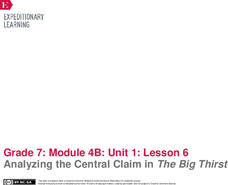Curated OER
Human Number Line
Fourth graders become aware and comprehend number relationships among those numbers most commonly found in geometric applications. They work in groups, 4th graders arrange themselves in order form the least to the greatest number in...
Curated OER
Five Themes of Geography
Middle schoolers choose one of the five themes of geography and create theme posters.
Curated OER
The Five Kingdoms
Fifth graders present research and information about the five kingdoms of living things using PowerPoint. They work in small groups in order to create a slideshow of 6 slides to present to the class. They give peer evaluations of the...
Curated OER
Breaking News English: Five Million Ecstasy Tablets Seized
In this English worksheet, students read "Five Million Ecstasy Tablets Seized," and then respond to 47 fill in the blank, 7 short answer, 20 matching, and 8 true or false questions about the selection.
Curated OER
Real-Life Problems: Time #2
How well can your third and fourth graders tell time? What about in word problems? Practice both with a worksheet that features five word problems about telling tme. Pupils use all four operations to solve the problems in spaces provided...
Alabama Learning Exchange
Time to Tell Time
Students demonstrate how to tell time using an analog clock. In this time measurement lesson, students read the book Clocks and More Clocks and use analog clocks to demonstrate the time that the teacher called out.
Curated OER
How Much Time?
This packet will help your learners read analog clocks and identify the elapsed time. Five pages full of practice opportunities are provided, and each question has a visual representation to aid youngsters.
Curated OER
Real-Life Problems
Choose your operation; scholars read five math-application word problems and determine which of four operations to use in solving each. They work with time and measurements, making sure to include the proper units in their solutions....
Curated OER
Regents Exam: Solving Rationals 1
In this rational number worksheet, students add and subtract fractions containing variables. They find common denominators and solve for the unknown. This four-page worksheet contains eighteen problems. Answers are listed on the last...
Curated OER
Elapsed Time
Introduce pupils to a skill they will use for the rest of their lives with these elapsed time word problems. There is a nice visual example to give them reference, and they work out five scenarios on their own. The times here are not...
EngageNY
Analyzing the Central Claim in The Big Thirst
Quench the class's thirst for knowledge while building analytical skills. Scholars listen as the teacher reads excerpt from the book The Big Thirst. They then complete a close read and answer text-dependent questions from pages one...
Curated OER
Fitness Notes - Weight Training
For this resource, the fitness notes cover the five principles of fitness, the principles of training/exercise, and cardio-respiratory fitness. The weight training notes cover the principles of weight training, proper techniques, and the...
Curated OER
Mission to Mars
Students consider the affects of space travel on the human body. In this human physiology instructional activity, students compare how the 5 different body systems work on Earth and in Space. Students then design a product that an...
EngageNY
Introducing Module 4B: “Water Is Life”
Learners take a gallery walk around the classroom to view various images and quotes. As they walk, they write down what they notice and wonder about what they see. After discussing their notice and wonder notes, they read the...
Science Matters
Earthquake Preparedness
Forty-five states and territories in the USA are at moderate to very high risk of earthquakes. The discussion-based lesson covers what to do before, during, and after an earthquake. The 14th lesson in the series includes how to...
Curated OER
Voice of History
Way before the digital age radio was the medium of popular culture. After listening to excerpts from radio programs (easily available on the Internet), participants return to the radio age by creating a two-minute sketch based on a...
Howard Hughes Medical Institute
Color Variation over Time in Rock Pocket Mouse Populations
A species-specific look at natural selection, the resource herein examines how adaptations have helped the population of rock pocket mice survive in a changing landscape. To begin, middle or high schoolers watch a 10.5 minute video,...
EngageNY
Solving General Systems of Linear Equations
Examine the usefulness of matrices when solving linear systems of higher dimensions. The lesson plan asks learners to write and solve systems of linear equations in four and five variables. Using matrices, pupils solve the systems and...
Curated OER
Teen Jobs: How to Find, Get, and Keep Employment
A five-day lesson on getting and keeping a job; what could be more beneficial to a young adult? They'll discuss how to locate a job, pick up and fill out an application, and nail the all important job interview. Resume writing,...
DiscoverE
Working with Watermills
Water is a powerful force; harness it through watermills. The task at hand is to create a simple watermill that functions in flowing water for at least three minutes. Scholars work together in teams to design and construct such a...
Curated OER
Power Walk and Jog
Throw in something different for your runners to focus on while they walk, jog, or run for five and a half minutes. Each time the runner passes you, hand them a playing card. There are several ideas on how to use them as motivators:...
K5 Learning
Race Cars
Do you ever get nervous before a big event? A pair of race cars discuss their nerves before tomorrow's race in a reading activity that includes five comprehension questions.
Film English
Pay It Forward
Centered around a film about giving to others freely, this plan incorporates collaborative work, discussion, and kindness. A still from the film starts off the plan as well as the prediction process. Class members then watch the film and...
DiscoverE
An Egg-Citing Ride
Wheeeee! Young thrill seekers build a bungee jump—not for themselves, though, but for an egg. The egg must fall from a height of five feet and rebound within two inches of the ground or floor.























